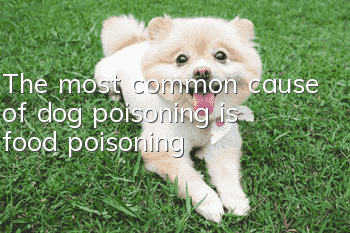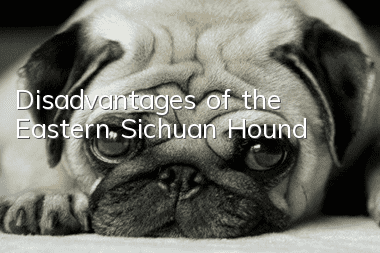The most common cause of dog poisoning is food poisoning

When the dog is left at home, or when the owner takes the dog for a walk, the dog may eat randomly if he is not careful, and he may accidentally get food poisoning. This kind of thing can be big or small. It is better to just treat the dog Taking the dog to the pet hospital and treating it is enough, but there are also many dogs that have died due to accidental ingestion! So when dogs eat by accident, we must learn to be calm and handle it calmly!
Food Poisoning
After dogs eat spoiled fish, meat, yogurt and other foods, they will be poisoned because these spoiled foods contain large amounts of Proteus, Staphylococcus toxins, Salmonella enterotoxin and Clostridium botulinum toxin. Deteriorated fish is contaminated by Proteus bacteria, which causes protein decomposition and the production of histamine. The incubation period of histamine poisoning does not exceed 2 hours. The dog suddenly vomits, has diarrhea, difficulty breathing, excessive nasal discharge, dilated pupils, and ataxia. The dog may be comatose, hindquarters paralyzed, weak, hematuria, and black feces. To treat spoiled fish poisoning, glucose and vitamin C can be injected intravenously or subcutaneously, diphenhydramine can be taken orally, and penicillin can be injected intramuscularly or subcutaneously
Staphylococcal toxin poisoning can cause symptoms of acute gastroenteritis, including vomiting, abdominal pain, and diarrhea in sick dogs. In severe cases, difficulty breathing, convulsions, and convulsions may occur. Treatment includes inducing vomiting, rehydration and symptomatic treatment. Gastric lavage and enema can be performed if necessary. Clostridium botulinum toxin can cause motor paralysis, coma, and even death in dogs. The symptoms of Clostridium botulinum poisoning in dogs are related to the amount ingested. In the early stage, the neck and shoulder muscles were paralyzed, followed by quadriplegia, slow reaction, dilated pupils, difficulty swallowing, salivation, and drooping ears. Conjunctivitis and ulcerative keratitis are more common in eyes. Finally died due to respiratory paralysis. Clostridium botulinum poisoning has a short course and high mortality. Antitoxin is injected immediately after onset, intravenously or intramuscularly. Symptomatic treatment can include gastric lavage with 0.01% potassium permanganate solution, administration of laxatives or enema, intravenous infusion, and intramuscular injection of penicillin. The best way to prevent this disease is that the dog's food should be cooked and not left out for long periods of time.
Rodenticide Poisoning
1. Poisoning by endogenous rodenticides. This is a powerful rodenticide, a white, odorless crystalline powder that causes the permeability of pulmonary capillaries to increase and a large amount of plasma to enter the lung tissue, causing pulmonary edema. A few minutes to a few hours after the dog ingests it, he will vomit, foam at the mouth, then have diarrhea, cough, difficulty breathing, depression, visible mucosal cyanosis, and foamy bloody mucus flowing from the nostrils. Coma and drowsiness usually occur 10-12 hours after ingestion, and a few die within 2-4 hours after ingestion. There is no specific antidote for this poisoning. Methods of inducing vomiting, gastric lavage, catharsis and diuresis can be used.
2. Zinc phosphide poisoning. This is a commonly used rodenticide that comes in the form of a gray powder. A few days after ingestion, it mixes with water and gastric acid in the stomach, releasing hydrogen phosphide gas and causing severe gastroenteritis. The sick dog suffered from abdominal pain, not eating, and continued vomiting.Coma, lethargy, rapid and deep breathing. Suffocation, diarrhea, blood in stool. For treatment, 0.2%-0.5% CuSO4 can be administered. 10-30 ml of solution to induce vomiting and expel toxins from the stomach. Gastric lavage can be performed with 0.02% KMnO4 solution, followed by 15 grams of Na2SO4 for catharsis. Intravenous injection of hypertonic glucose solution is beneficial to liver protection.
3. Poisoning by organofluoride rodenticides. This is a highly poisonous drug. The sick dog will become restless, vomit, have gastrointestinal hyperfunction, run around, bark, and have paroxysmal spasms of the whole body for about 1 minute after taking it, and finally die. Treatment can be treated with intramuscular injection of fluorine, 0.1-0.2 grams per kilogram of body weight. The first dosage is 1/2 of the whole day's dosage, and the remaining 1/2 is divided into 4 parts and injected every 2 hours. Combined with inducing vomiting and gastric lavage. Feeding sick dogs raw egg white will help protect the mucosa of the digestive tract. Intravenous injection of 5-10 ml of calcium gluconate is beneficial.
Organophosphorus pesticide poisoning
Organophosphorus is widely used in agriculture as pesticides, such as trichlorfon, dimethoate, dichlorvos, etc. Accidental ingestion can cause excessive salivation, tearing, diarrhea, abdominal pain, urinary incontinence, difficulty breathing, coughing, conjunctival cyanosis, muscle twitching, and subsequent paralysis, miosis, and coma in dogs. Most deaths occur due to respiratory impairment. During treatment, first slowly inject atropine sulfate at a rate of 0.05 mg per kilogram of body weight intravenously. After an interval of 6 hours, inject 0.15 mg of atropine sulfate per kilogram of body weight subcutaneously or intramuscularly. Pralidoxime may enhance the functions of atropine. Medicines that relieve muscle spasms can help relieve symptoms. Some dogs are allergic to pralidoxime and pralidoxime chloride, so attention should be paid.
Chlorinated hydrocarbon poisoning
Such pesticides include DDT, 666, etc. Causes the dog to be extremely excited, restless or highly depressed. The head and neck muscles will first tremble, and then spread to the whole body, with muscle spasm and contraction, and then depression; continuous bleeding, not eating or eating less, and diarrhea. Cleansing and gastric lavage can be used during treatment, and then salt laxatives can be used for catharsis. Hyperexcitability in dogs can be treated symptomatically by administering sedatives. Since the dog is dehydrated and not eating, intravenous fluids should be given.
- How to deworm a poodle?
- What should I do if my puppy keeps barking?
- How long can a Pomeranian live with kidney failure?
- How to practice dog movements and how many months does it take?
- How to care for pet dog hair in the hot summer, a must-read for poop collectors!
- Living habits of Chinese Shar Pei dogs
- How much dog food should a two-month-old puppy eat?
- Close contact with dogs, four tips for getting rid of dog bad breath!
- How to choose dog food for elderly dogs
- How many minutes does it take for a puppy to nurse?



